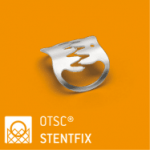stentfix OTSC® | 76.5% relative risk reduction of SEMS migration
stentfix OTSC®: 76.5% relative risk reduction of SEMS migration associated with utilization of stentfix OTSC® System
Retrospective cohort study including 77 patients with benign or malignant gastroesophageal diseases compared 26 patients undergoing SEMS fixation with stentfix OTSC (SF cohort) to a historical cohort of 51 patients without SEMS fixation (NF cohort). In the SF cohort, technical success rate was 100 %, and stent migration rate was significantly lower than in the NF cohort (8.3 % vs 35.4 %, p<0.001). In the SF group, no procedure-related adverse events were observed.
M. Schiemer et al., Department of Medicine II, University Medical Center Freiburg, Freiburg, Germany performed a retrospective cohort study aiming to evaluate the frequency of stent migration before and after availability of the stentfix OTSC device.
Self-expandable metal stents (SEMS) are routinely used to restore luminal patency in patients with dysphagia caused by malignant esophageal strictures as well as for the management of benign gastroesophageal diseases such as fistulas, anastomotic leaks, perforations and refractory acute variceal bleeding.
For the study, a cohort of consecutive patients who underwent SEMS placement with stentfix OTSC fixation (SF cohort) was compared with a historical cohort of consecutive patients without any stent fixation (NF cohort). Stent migration was defined as a clinically relevant stent dislocation ≥ 2cm as detected by follow-up endoscopy or imaging. Endoscopic re-interventions were performed in cases of suspected adverse events and for stent removal in cases of intended temporary stent placement. All available follow-up examinations were taken into account for the detection of stent migration. Secondary outcome measures were technical success, clinical success (defined as improvement of dysphagia and closure of perforations, fistulas and leaks), and adverse events.
Overall 77 patients (SF cohort: n=26, NF cohort: n = 51) underwent esophageal SEMS implantation for malignant (69 %) and benign (31%) gastroesophageal diseases. The cohorts were comparable in terms of age, sex, stent position, stent diameter and duration of follow-up. In the NF cohort, the proportion of patients with malignant conditions was higher (74.5% vs. 57.7%, p=0.193). In the SF group 50% partial and 50% fully covered stents were used while in the NF group most patients had partially covered stents (71%).
The technical success rate of stent fixation with the stentfix OTSC was 100 % and no adverse events related to clip application or removal were observed. Stent migration occurred in two patients (8.3 %) in the SF cohort versus 17 patients (35.4 %) in the NF cohort (p<0.001), indicating a relative risk reduction of 76.5 % associated with stentfix OTSC application. Clinical success was observed in 20 patients (87.0%) in the SF cohort and 34 patients (72.3%) in the NF cohort. The difference was not statistically significant (p=0.171).
The authors concluded that in patients with benign or malignant gastroesophageal diseases, there was a significantly lower stent migration rate in patients managed with the stentfix OTSC system compared with those without stent fixation. The application was technically successful in all cases and no procedure-related adverse events were observed.
Reduction of esophageal stent migration rate with a novel over-the-scope fixation device
Schiemer M, Bettinger D, Mueller J, Schultheiss M, Schwacha H, Hasselblatt P, Thimme R, Schmidt A, Kuellmer A
Gastrointestinal Endoscopy (2022)
https://doi.org/10.1016/j.gie.2022.02.001

|
 |


 English
English  Français
Français 